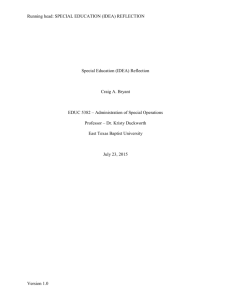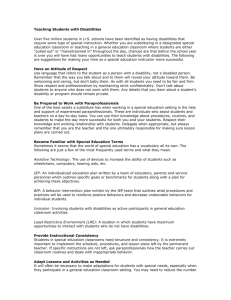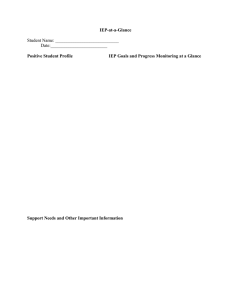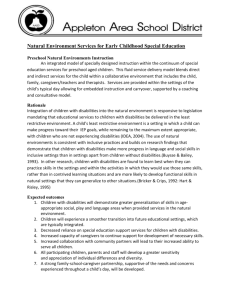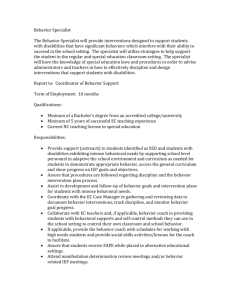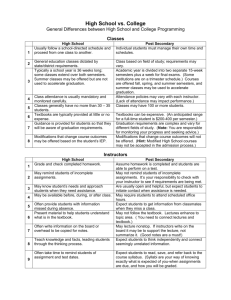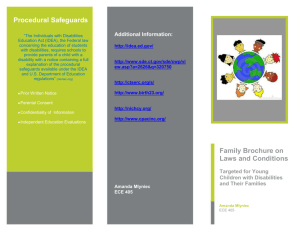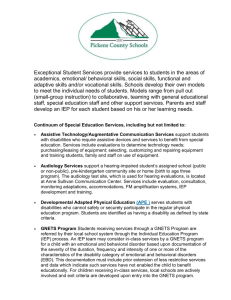TUSD Special Education TTIP Presentation
advertisement
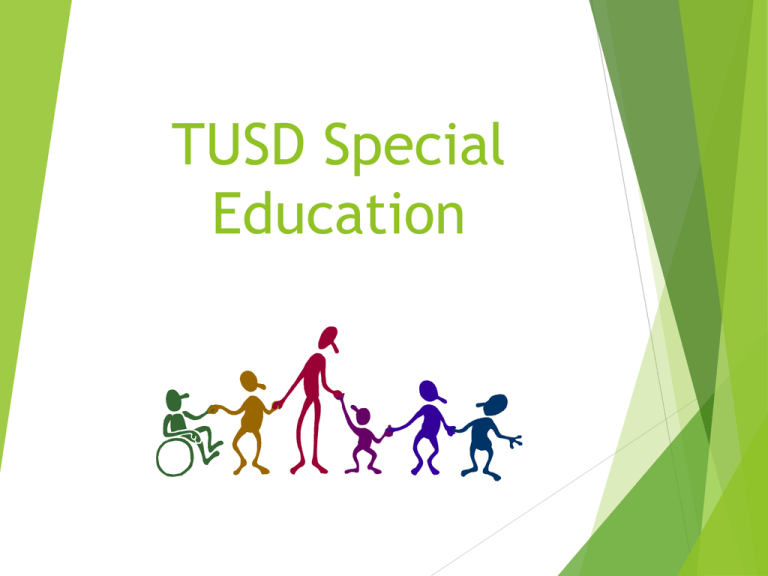
TUSD Special Education IDEA Individuals with Disabilities Education Act Definition: Established by the government to ensure that children with disabilities have instruction that meets their unique needs. This is a federal law that requires public schools to provide a Free Appropriate Public Education (FAPE) to children with disabilities. IDEA regulations require schools to conduct activities to find and diagnose children with disabilities from ages 3 to 21. It is also required that schools provide a complete educational evaluation to children to determine if they need special education services. http://learningdisabilities.about.com IDEA Individuals with Disabilities Education Act What does an IDEA Special Education include? For eligible students, schools must develop an Individual Education Program (IEP) that acts as a kind of educational map of the child’s needs and sets goals for improvement. The IEP includes a description of Specially Designed Instruction (SDI) that will be provided to help the child reach his educational goals. If the child also needs related services to reach goals, the IEP describes what those will include. These must be reviewed annually and the child must be re-evaluated every three years. http://learningdisabilities.about.com IDEA Individuals with Disabilities Education Act What are the requirements for SPED placements? To the greatest extent appropriate, students are to be placed, or educated, with their non-disabled peers in the Least Restrictive Environment (LRE). However, if a child needs more intensive services, and a smaller class would be most appropriate, schools are required to provide that. In rare situation where students must be served in special schools, at home, or in hospitals, schools must continue to provide educational services. http://learningdisabilities.about.com So, what does this all mean? • Gen Ed teachers are required by law to attend IEP meetings. • Gen Ed teachers are responsible for the education of the special needs student(s) within their class • Referrals to SPED may be initiated after Gen Ed interventions and PSP/SST procedures have been implemented. Help me help them! PSP/SST Process (Problem Solving Process/Student Success Team) This is not a Special Ed. function! However, most sites have the School Psychologist and RSP teacher on the team. WHAT TO BRING:District Assessment results Running records (i.e. grade book) Work Samples Interventions THE GOAL: is to help students be successful in the general education classroom. POSSIBLE OUTCOMES: more interventions, 504 plan, referral for SPED assessment. It is important to take the time to go through the student’s cum and to keep a good record system of assessment scores and work production. Make sure the plan includes specific strategies that the teacher can implement and really address the concerns. Which in turn can give the student strategies to independently be successful. Again, make sure you go through the students cum. It’s important to invite the appropriate parties if the student is in Foster Care. Remember, with all the fill ins on this form, they may not cover all the concerns you have. Use this space and cover everything about the kiddo, even if it’s a minor concern. You must consider multiple evaluation information when looking at eligibility. background Disciplinary records Assessment results This information can come from parents, teachers, and other adults involved in the student’s life. Now rate the major life activity and give justification. Who? At the Middle & High School it should be the counselors and/or the Vice Principal. At the Elementary Level it should be the Principal or Designee. Make sure that any disagreement with the information presented is recorded. Try to record the rationale behind the disagreement. The form at your site may not have this box included. But you will have to take that information from the Eligibility form and put the impairment and major activity involved on this form. This page will have ideas of intervention and supports to guide the student’s success in the Gen. Ed. classroom. However, PLEASE REMEMBER THE RESPONSIBLE PARTIES ARE THE ADULTS NOT THE STUDENTS! Again, it is very important to record any and all disagreements. Examples of Accommodations & Modifications General ACCOMMODATIONS Behavior Breaks between tasks Large Print Textbooks Books on Tape Cue expected behavior Textbooks for home Graphic organizers Daily home/school feedback to student/parent Additional time Answers to be dictated Have contingency plans Review Sessions Study sheets Use proximity control Rest Breaks Teacher outlines given Use of peer supports and mentoring Peer note taker Agenda book or checklist Have parent sign homework Spelling errors ok Open book/notes test Use positive reinforcement (rewards) • MODIFICATIONS Allow outlining instead of writing an essay Projects instead of a written report Alternative book/materials on the topic Highlight important words/phrase in reading Shorten length of assignment/test Pass/no pass option or grades based on IEP Film/video in supplements in place of reading text Use negative reinforcement (consequences) Post rules with consequences Implements behavioral academic contracts Write contract for student behavior Implement self recording of behavior Knowing that YOU will be a teacher in the life of a student, how do you hope to succeed? (share at your table) Now we will end our session with a video: Rita Pierson: Every Kid Needs a Champion
